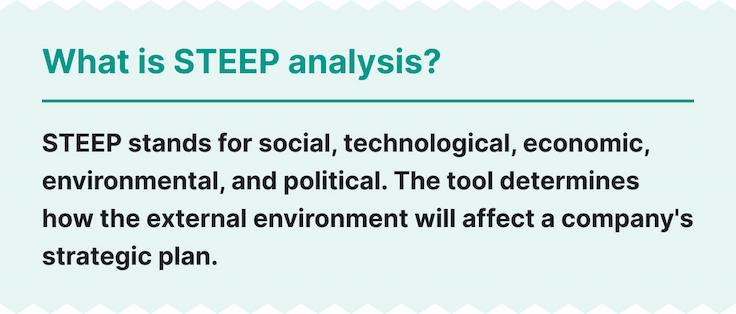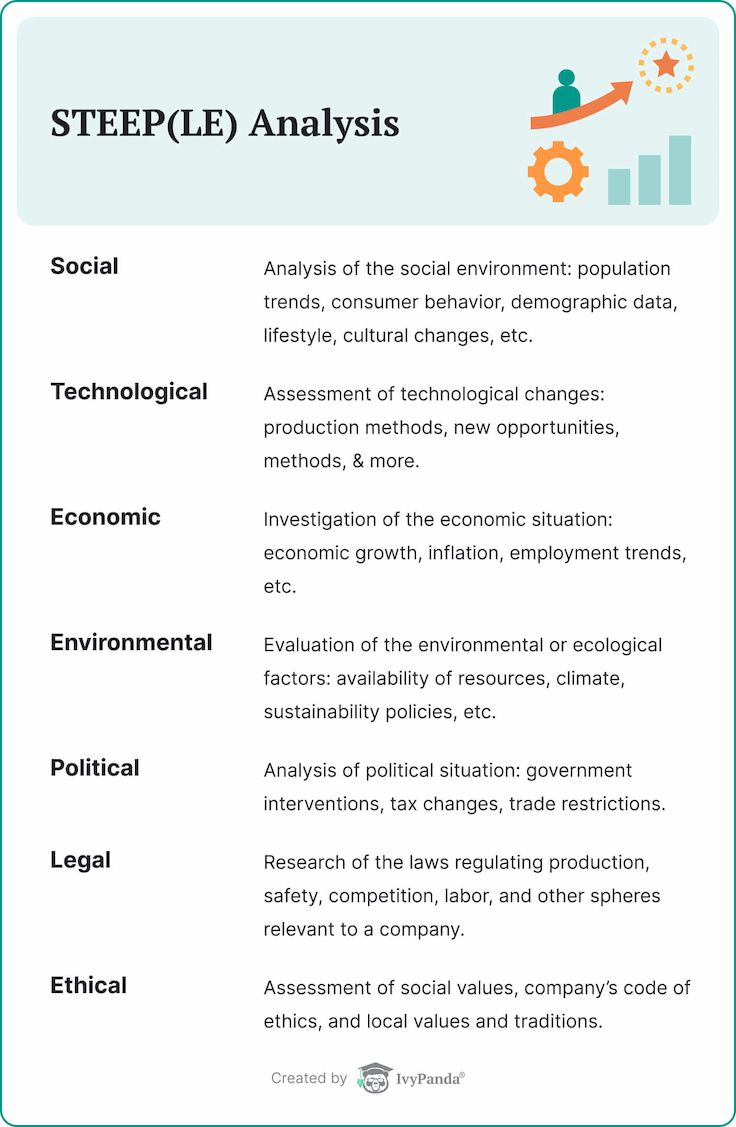STEEP Analysis Template for Free + Examples
To use the STEEP analysis template, perform 3 simple actions: input the data, pick the best design, and hit the button to get the result. Try it out yourself!
Looking for a STEEP analysis template? The STEEP online tool above is free and easy-to-use. Go on reading to learn how to conduct a STEEPLE analysis.
👉 How to Use STEEP Analysis Template
To conduct STEEP analysis, you need to gather data and follow this plan:
- Gather the components you are going to analyze.
- Evaluate the relationships between multiple trends.
- Connect the problems to the trends.
- Predict the future course of the issues.
- Calculate the repercussions.
For a more detailed explanation, check out the sections below
🔑 STEEP Framework Explained
Analysts, businesspeople, and researchers use STEEP analysis to understand how economic downturns and (im-)proper investments impact the planning process of a company. Read below to get more information about the STEEP framework.

What Is STEEP Analysis?
The STEEP (social, technological, economic, environmental, and political) analysis is an extended version of the PEST analysis. This method is frequently used in marketing to assess external (macro) elements that impact a firm. The STEEP framework can also forecast potential events within the company and help thoroughly understand what external factors influence the major trends.
How to Conduct a STEEP Analysis?
To use the framework of STEEP analysis, you have to take 5 fundamental steps:
- Determine each group of factors. You must find current events or trends proving the factor's existence. Additionally, you need to comprehend the historical development of these trends and their short and long-term effects.
- Assess the connection between the trends. Determining how each trend interacts with one of the five external areas is crucial. Find the conflicts and determine how trends are related to one another.
- Relate trends to a business issue. These are trends that have the potential to either support or undermine a company's ability to execute its strategy. The company should choose the methods that have the most excellent chance of having an impact.
- Identify the course of potential issues. This process goes beyond merely compiling data. It would help if you determined the driving forces behind the fundamental problems and the causes of trends.
- Conclude the results. A firm conclusion should explain the possible effects of many environmental influences on business success. Overall, it must determine how the external environment will impact the current and future strategies.
Differences Between SWOT, PEST, and STEEP
SWOT, STEEP, and PEST analysis have much in common, yet they still differ. For example, the most critical distinction of the STEEP analysis is that it covers environmental factors.
- A PEST study discovers political, economic, social, and technological factors evaluating market trends and changes.
- A SWOT analysis is a subjective evaluation of company information that helps understand and discuss data and make crucial decisions. This approach can also evaluate the company's competencies, business solutions, and organizational capabilities.

🥤 STEEP Examples: PepsiCo Analysis
PepsiCo is the leading international beverage seller after Coca-Cola. The market reach of Pepsi is likewise very varied. Pepsi is available practically everywhere, from the US to New Zealand. Here is the STEEP analysis example of PepsiCo:
🎁 STEEP Analysis Template Benefits
Our STEEP analysis template tool has many benefits:
- Simplicity. The tool is simple and easy to use. It will save a lot of your time and effort.
- Flexible design. The design of our tool is one of its most prominent benefits; you can create anything you want.
- Speed & accuracy. Our online tool is automatic; there is no need to wait long hours to conduct the analysis – just a couple of clicks!
- No-fee service. You can use our STEEP analysis template whenever you need it without spending a cent.
- Accessibility online. Access our online tool from any device with just an internet connection.
Thank you for reading this article! We hope that the information above was useful. Check our other online writing tools to polish your assignment or get inspired.
Updated: